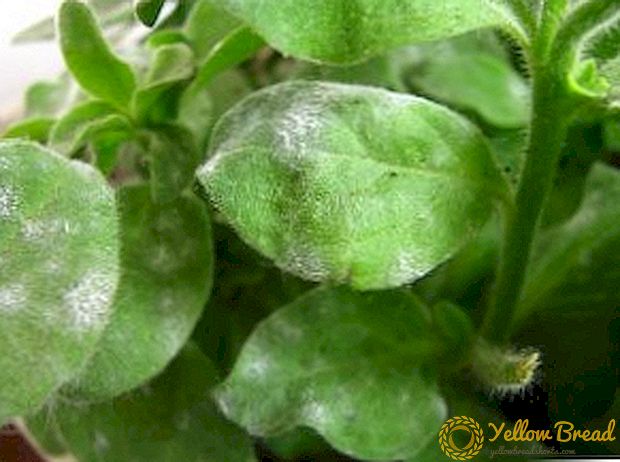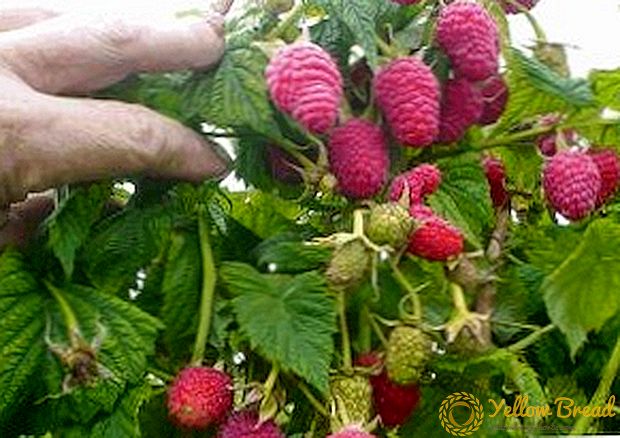 Sooner or later, unfortunately, every summer resident and a gardener has to face a problem when it is necessary to apply fungicides.
Sooner or later, unfortunately, every summer resident and a gardener has to face a problem when it is necessary to apply fungicides.
Since their range today is huge, the choice of one of them sometimes becomes a difficult task.
In addition, I want the drug to be both effective and minimally harmful. In this article, we introduce you to the tool "Alirin B" and instructions for its use.
- "Alirin B": description and forms of production of the drug
- Mechanism of action and active ingredient "Alirin B"
- How to apply "Alirin B", detailed instructions
- Vegetable crops
- Berries
- Fruit
- Lawn grass
- Indoor Floriculture
- Compatibility "Alirin B" with other drugs
- Security measures when using fungicide
- How to store "Alirin B"
"Alirin B": description and forms of production of the drug
 "Alirin B" - biological fungicide that allows you to fight fungal diseases in garden plants and indoor crops. According to the manufacturers, this tool does not pose a danger to humans, animals or the environment. Treats low-dangerous preparations with a class of danger - 4. Its decay products do not accumulate in the plant itself or in its fruits. This means that the fruit can be eaten even directly after processing.
"Alirin B" - biological fungicide that allows you to fight fungal diseases in garden plants and indoor crops. According to the manufacturers, this tool does not pose a danger to humans, animals or the environment. Treats low-dangerous preparations with a class of danger - 4. Its decay products do not accumulate in the plant itself or in its fruits. This means that the fruit can be eaten even directly after processing.
The product is medium hazard for bees (hazard class - 3). It is forbidden to use it in the water protection zone.
The drug "Alirin B" is produced in three forms: dry powder, liquid and tablets. The first two forms are used in agriculture, pill form - in garden plots.
Mechanism of action and active ingredient "Alirin B"
The active substances of this fungicide are soil bacteria Bacillus subtilis, strain B-10 VIZR. These bacteria are able to inhibit growth and reduce the number of most pathogenic fungi. At the same time do not attract addiction from pathogens.
 The mechanism of action of the drug is as follows: it increases the content of protein and ascorbic acid by 20-30% in plants, restores microflora in the soil and reduces the level of nitrates in it by 25-40%.
The mechanism of action of the drug is as follows: it increases the content of protein and ascorbic acid by 20-30% in plants, restores microflora in the soil and reduces the level of nitrates in it by 25-40%.
It starts from the moment it is processed. The period covered by the protective action of "Alirin B" is one to two weeks.Means process plants and soil.
How to apply "Alirin B", detailed instructions
The drug is used for the prevention and treatment of most fungal diseases of plants: root and gray rot, rust, cercosporosis, powdery mildew, tracheomycous wilt, peronosporaz, moniliasis, late blight, scab.
"Alirin B" is suitable for the treatment of inhabitants of open soil - vegetable plants, berry bushes, fruit trees, lawn herbs, - so it can be applied and indoor flowers. The drug is used on open and protected ground.
Fungicide is used for spraying or watering - it is introduced into the soil, under the roots and into the wells. For watering The consumption rate is 2 tablets per 10 liters of water. The finished liquid is consumed at the rate of: 10 liters per 10 square meters. m
For spraying apply a solution of 2 tablets to 1 liter of water. First, the tablets are dissolved in 200-300 ml of water, and then the solution is adjusted to the required amount of liquid according to the dosage. Also, liquid soap or another adhesive (1 ml of liquid soap / 10 l) interferes with the spray solution. It is possible to replace the soap on stimulators "Ribav-Extra", "Zircon", "Appin". 
When processing for the purpose of prevention the consumption rate should be halved.
Vegetable crops
For prophylaxis Fungal diseases in vegetable plants that are grown in vegetable gardens and in greenhouses, before planting seedlings or sowing seeds (for a couple of days) “Alirin B” cultivates the soil. This is done with the help of a watering can or sprayer. After the introduction of the drug, the soil is loosened 15-20 cm deep. Subsequent two treatments are carried out at intervals of one to two weeks. For tillage, 2 tablets of the drug are dissolved in 10 liters of water. Watering is carried out at the rate of 10 liters of solution / 10 square meters. m
Also, "Alirin B", as advised by manufacturers, is introduced into the well: 1 tablet should be diluted in 1 liter of water. 200 g of this solution is injected into each well.
With the disease vegetable plants root and root rot, late blight irrigation is carried out during the growing season. The procedure should be carried out 2-3 or more times with intervals of 5-7 days. In consumption is 2 tablets per 10 liters of water. Liquid consumption - 10 liters per 10 square meters. m

Avoid vegetables, berries (currants, strawberries, gooseberries, etc.) and ornamental crops (asters, chrysanthemums, roses, etc.) powdery mildew, Alternaria, cladosporia, Septoria, downy mildew, anthracnose, white and gray rot, apply two- and threefold preventive sprays. The interval between them should be 14 days.
Medical treatment is carried out when symptoms of these diseases appear. Spraying spend 2-3 times with intervals of 5-6 days.
To protect the potatoes from late blight and rhizoctoniosis, pre-treatment of tubers is carried out. Calculation: 4-6 tablets per 10 kg tubers. The finished liquid for such an amount of potatoes will be 200-300 ml.
In the future, spend processing potatoes against late blight. The first spraying is carried out in the period of closure of the rows, the next - in 10-12 days. Consumption rate for spraying - 1 tablet per 10 liters of water. 10 liters of the finished solution is treated with 100 square meters. m
Berries
On the use of "Alirin B" tablets for the prevention and treatment of diseases in most berry crops, we wrote above. Separately, it is worth mentioning strawberries, the spray pattern of which is different. 
With the defeat of this culture with gray rot with a solution for spraying with the addition of adhesive, the treatment is carried out before the buds are advanced. After flowering, perform a single spraying (1 tablet / 1 liter of water). For the third time, strawberries are sprayed after fruiting.
The drug is also suitable for getting rid of American powdery mildew in black currants. In this case, a solution of 1 tablet per 1 liter of water is treated with a berry plant before flowering, after flowering, at the very beginning of the formation of the fruit.
In the same way you can fight with the gray rot in the gooseberry.
Fruit
Fruit crops with the help of "Alirina B" carry out preventive spraying against scab and moniliosis. The first treatment is carried out before the extension of the buds, the second - after flowering, the third - in two weeks. Last spraying should be done in mid-August. Consumption rate - 1 tablet per 1 liter of water.

Lawn grass
"Alirin B" has been used for preventive irrigation against root and stem rot in lawn grasses. The soil is watered for 1-3 days before sowing seeds and make a digging 15-25 cm deep.
Recommended and seed treatment before sowing. The consumption rate is 1 table. on 1 l of water.
With the defeat of such serious diseases as rust, septoria and powdery mildew, they apply lawn sprays: 2-3 times after germination or several times with intervals of 5-7 days. If mass infection has occurred, then spraying with biofungicide should be alternated with chemical treatment.
Indoor Floriculture
"Alirin B" is suitable for the treatment of indoor flowers. Its action will help protect domestic plants from root rot and tracheomycous wilt. The drug is made during transplantation. Before planting the plant, the soil is soaked in a solution of 2 tablets per 1 liter of water. Consumption of finished fluid - 100-200 ml per 1 sq. Km. m 
It is also possible to water the plants under the root. They are produced three times at a rate of 1 tablet per 5 liters of water. Depending on the size of the plant and the pot, 200 ml - 1 l of working fluid will go into one copy.It is necessary to adhere to intervals between waterings in 7-14 days.
Spraying plants during the growing season will reduce the risk of powdery mildew and gray rot. Consumption rate - 2 tablets per 1 liter of water. 100-200 ml of the prepared solution is used per 1 sq. M. m
Flower plants in open areas are treated in the same way.
Compatibility "Alirin B" with other drugs
"Alirin B" can be combined with other biological products, agrochemicals and growth stimulants. It is forbidden to use it simultaneously with chemical bactericides. If such treatment is necessary, then the plants should be sprayed with a biopreparation and chemical means alternately. The weekly interval must be observed when using Glyocladin.
Security measures when using fungicide
When using any fungicides, it is important to follow the rules of personal safety. Requirements when working with "Alirin B" relate to the protection of hands with gloves. At the same time during processing it is forbidden to eat or drink, as well as smoke.
If the drug is still in the human body, you should drink at least two glasses of water with pre-dissolved activated carbon (1-2 tbsp.spoon) and induce vomiting.
Means penetrated through the respiratory system - immediately go to fresh air. If the mucous membrane of the eye is affected, it should be rinsed well with water. The area of the skin where the fungicide has dropped is washed with water using soap.
When transporting after purchase, check that the product does not lie next to food, drinks, pet food and medicines.
How to store "Alirin B"
Manufacturers recommend storing "Alirin B" tablets in a dry room at a temperature of -30 - +30 ° C. If the integrity of the packaging is not compromised, the shelf life is three years.
The drug in the form of a liquid at a temperature of 0 to +8 ° C is suitable for use for four months from the date of manufacture. Keep in places where children and pets do not have access.
The diluted solution must be used the same day it was prepared. It can not be stored.






